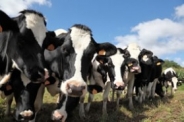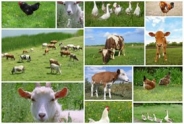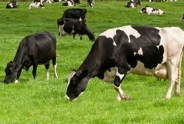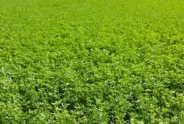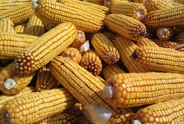Those Pesky Pasture Flies! Take the Integrated Approach to Control
Nancy Glazier, Small Farms & Livestock Specialist
Northwest New York Dairy, Livestock & Field Crops
June 27, 2013
They can cause stresses on animals; they reduce grazing time which in turn reduces production. These reductions can be seasonal, or with youngstock, cumulative. With current input and output (meat and milk) prices heading up, this season will be even more critical to manage pests.
The focus of this article will be the "Big Three": face fly, horn fly and stable fly. They each have their own feeding areas on livestock, but have similar life cycles. They all have complete metamorphosis, which means they lay eggs that hatch into larvae, then pupate and emerge as adults. Critical for control is identification, habitat management, monitoring and assessment.
The face fly was native to Europe and was first found in Nova Scotia around 1950. It spread to 26 states by 1960 and is now found in most of the US. The fly resembles the house fly, but is about 20% larger. It is a non-biting fly where the female feeds on proteins around the face; they hang out near the eyes, muzzle and mouth. They can serve as vectors for diseases such as pink eye. Also, they can congregate around wounds and feed on blood. Males generally feed on nectar and hang out on fenceposts or branches to wait for the females as they move about. After mating, the female lays her eggs (up to 600) on very fresh manure. The time from egg to adult is 2-3 weeks, depending on temperatures.
The horn fly is about half the size of the face fly. It also came from Europe, being first observed in the US in 1887 and is now generally distributed. Both males and female horn flies feed by biting and take up to 20 blood meals a day. They will congregate on backs and shoulders of livestock. The female will lay 200-400 eggs in her life on fresh, undisturbed manure.
The stable fly is another biting fly found worldwide. It is dark gray and slightly smaller than the house fly. This species is seen on the legs of livestock; when they congregate on animals, they stomp their feet to try to dislodge them. The female is less specific where she lays her eggs (200-400). Eggs may be laid on moist organic matter such as manure, spilled feeds, silage, grass clippings, and vegetation on edges of ponds and lakes. This fly can travel up to 20 miles on storms! They are the ones that stop by and take a bite on your ankles when you're out in the yard.
So once you've figured out the species, you'll need to get a count of the numbers present. This takes some time out on pastures with the livestock. A good representation is needed, the more animals the better, with a minimum of 5 to 10; 15 is better. You need to get close enough to count, so move slowly. And I suggest not doing this when you move fence unless you give the livestock time to move and settle in to the new paddock. Sample on a weekly basis at roughly the same time and write down what you see. A pocket pad works well.
Thresholds:
Face fly - 10 flies/face.
Horn fly - about 50 flies per side for dairy, about 100 flies per side for beef.
Stable fly - 10 flies/4 legs of the animal.
Control can involve cultural, mechanical, biological and chemical; some years it may take a combination of methods. Habitat management is a critical step in breaking the life cycle and proliferation. When a female lays 400 eggs over the course of 3-4 weeks, populations can explode if not controlled. Keep feeds dry, clean up spills, move outside feeding areas if possible. On pastures, some producers utilize pasture chains or drags to disperse manure pats so they dry out more quickly. Check to see if you have ground beetles and dung beetles cleaning up those manure pats. This isn't very pleasant, but it helps with management.
Various traps are on the market. These are a mechanical means to capture the flies. Some are for livestock to walk through and flies get trapped in screens, some employ sticky surfaces, while others use attractants.
Birds (even poultry), bugs, spiders, mites, and diseases can help control populations. Some producers purchase parasitoid wasps to release during fly season. These wasps lay eggs on larvae; their eggs hatch and the larvae burrow into the maggots and kill them.
The more traditional approach is chemical: sprays, rubs, dusters, etc. If you use chemical control options, some can kill beneficial insects as well.
This is an overview of the 3 flies and a short look at control. An excellent resource for more information is, Integrated Pest Management (IPM) Guide for Organic Dairies from NYS IPM program. It can be downloaded at: http://www.nysipm.cornell.edu/organic_guide/dairy.pdf. Conventional and beef operations could benefit from this as well.
Thanks to Keith Waldron, NYS IPM, for sharing information on this subject with me to write this article.
Upcoming Events
Cornell Cow Convos Podcast- Episode 8 Release
April 25, 2024
Cornell Cow Convos-Episode 8
Western NY Value-Added Dairy Discussion Group: Jess May- Farm Credit East Webinar
May 2, 2024 : Value-Added Dairy Discussion Group Webinar: Jess May- Farm Credit East
Register here:
https://cornell.zoom.us/webina...
Western NY Value-Added Dairy Discussion Group: Eden Valley Creamery
May 3, 2024
South Dayton, NY
Registration for this discussion group is required and limited.
Announcements
Follow us on Instagram
See photos and reels of our most recent events and programs!Join us on Facebook!
Follow us on Facebook to get up to date posts about events, workshops and everything NWNY!Add us on LinkedIn!
Connect with us on LinkedIn to get more information about upcoming workshops and programs!

